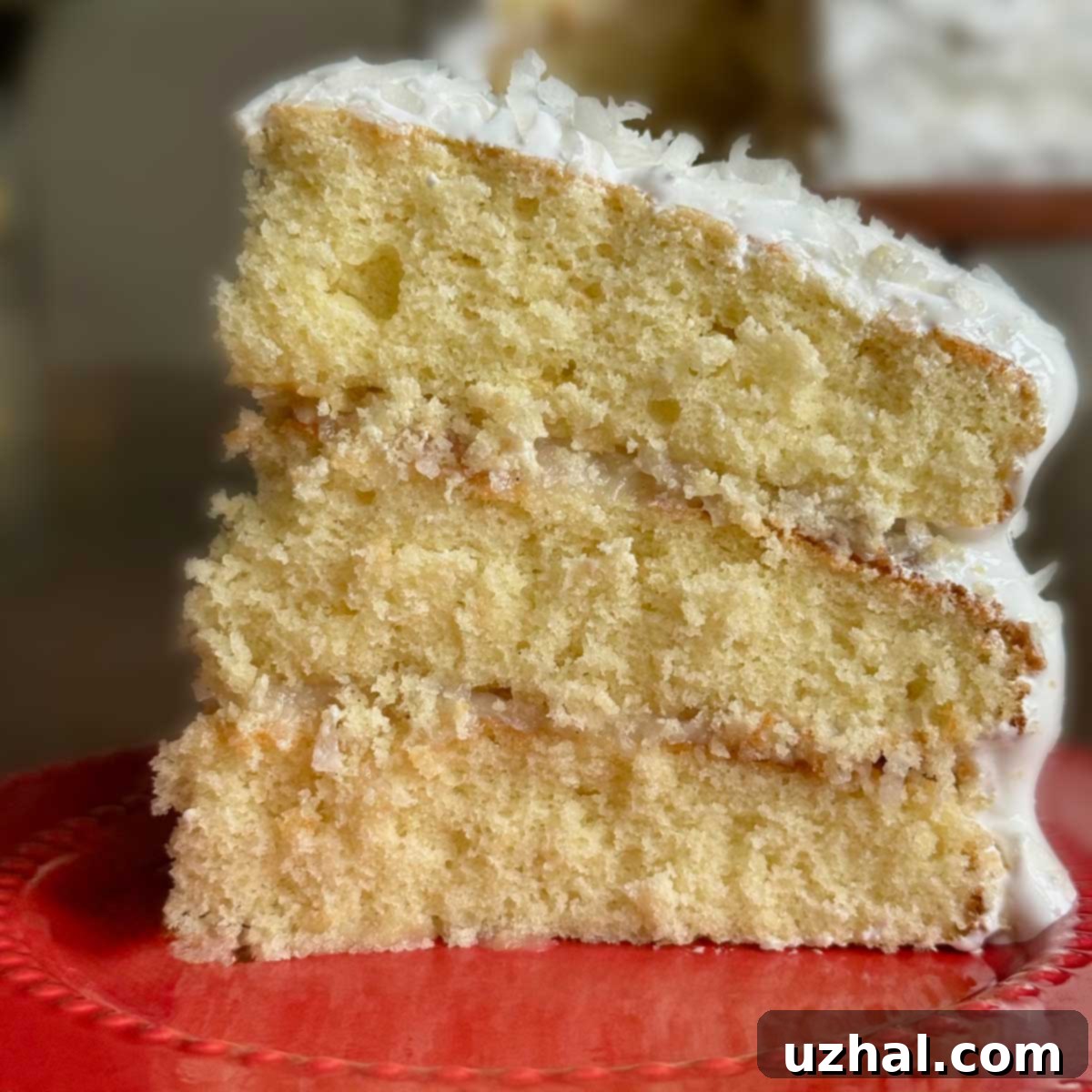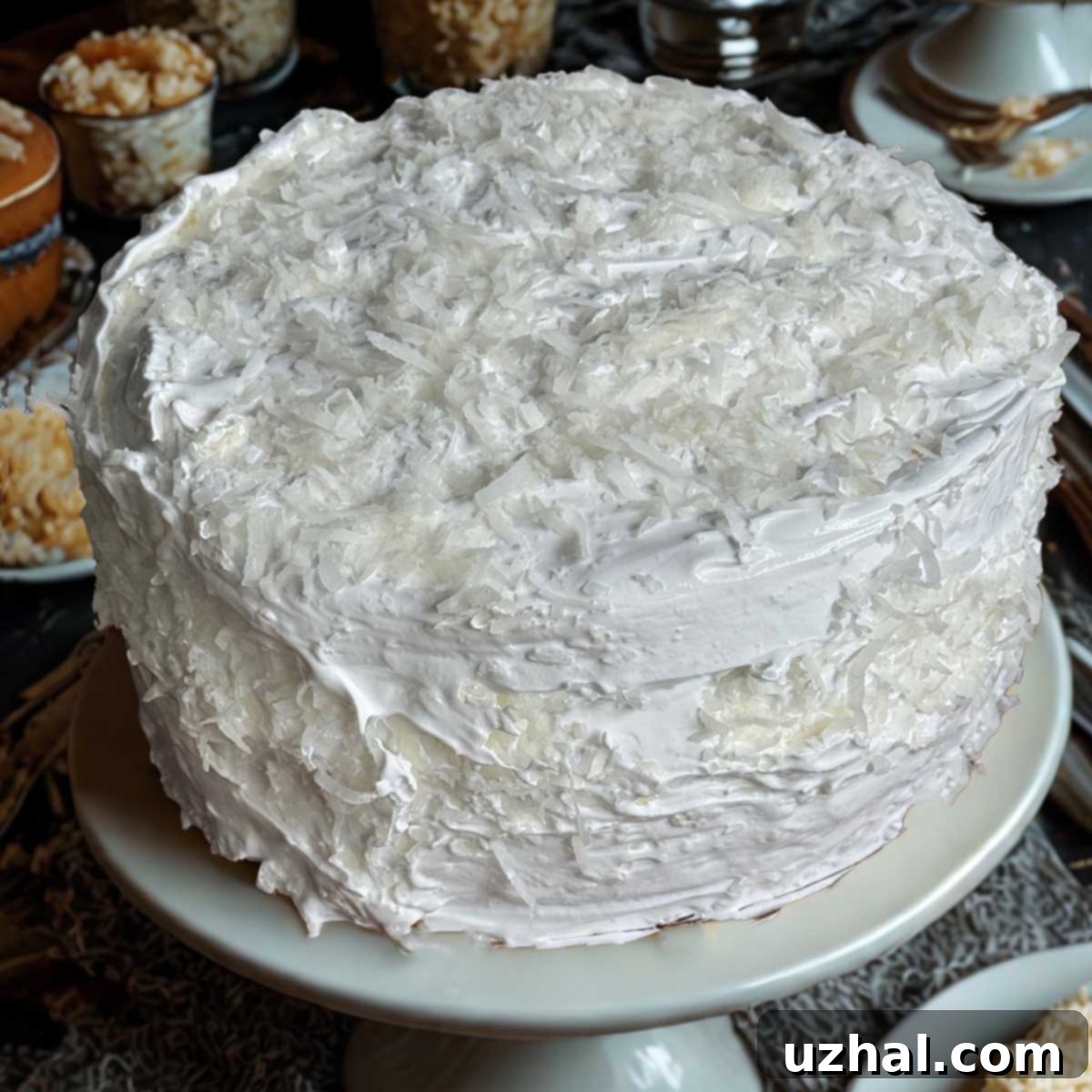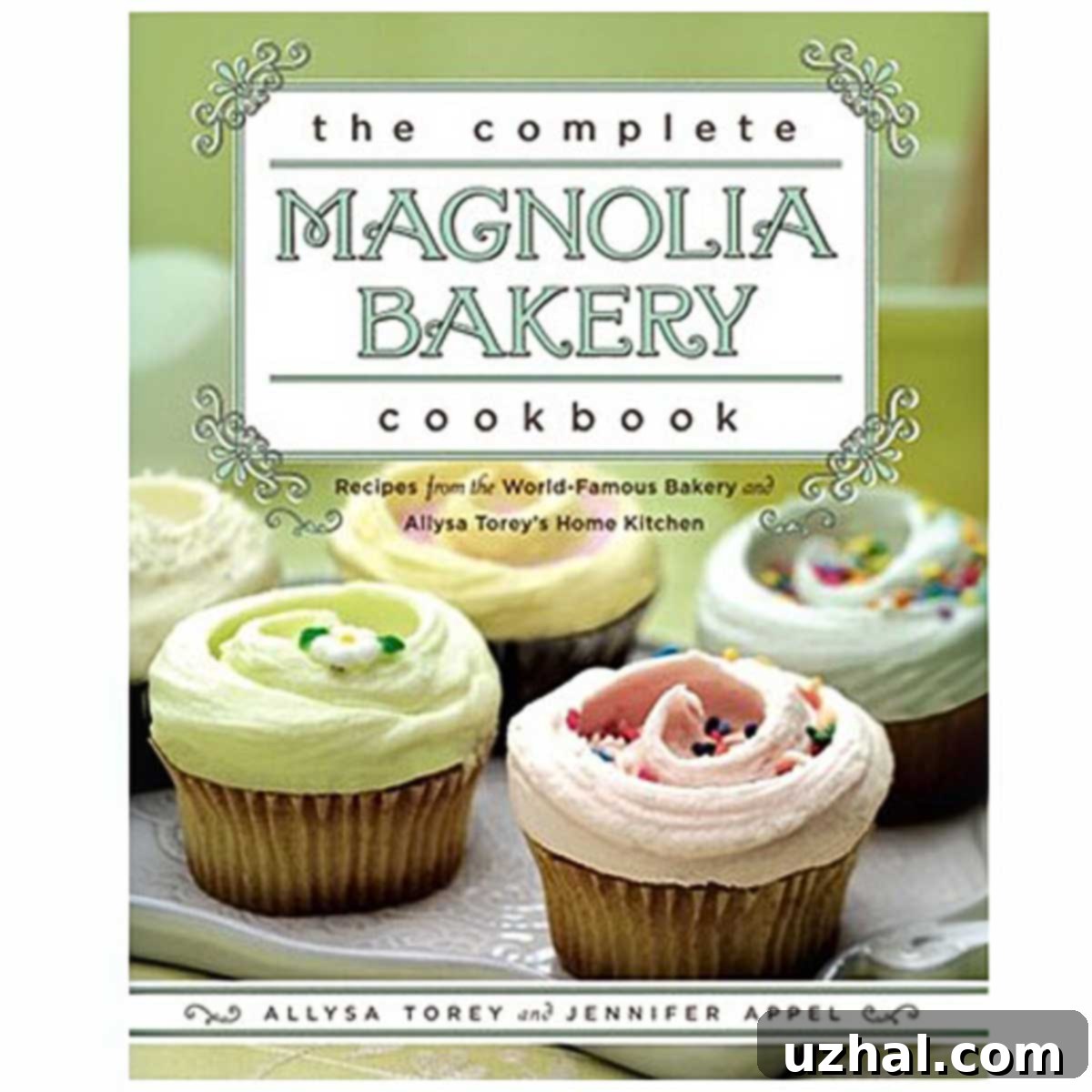Magnolia Bakery’s Iconic Coconut Layer Cake: A Classic Recipe Guide
The Magnolia Bakery Coconut Cake stands as a true testament to classic American baking, a beloved dessert cherished for its exquisite flavor and delightful texture. This particular recipe was one of the first I enthusiastically tackled from The Complete Magnolia Bakery Cookbook: Recipes from the World-Famous Bakery and Allysa Torey’s Home Kitchen, a book that quickly earned its place as a staple in my kitchen. Having shared an earlier version of this delight, I’m thrilled to present it now in a comprehensive, updated format, complete with fresh insights and soon, new photographs to do this stunning cake justice.
For any baking enthusiast, this cookbook is an absolute treasure trove. It’s brimming with reliable, delicious recipes that consistently deliver outstanding results, making it a worthwhile investment for any home baker. One of the distinguishing characteristics you’ll quickly notice across many of Magnolia Bakery’s cake recipes, including this coconut layer cake, is their innovative use of a dual-flour blend: both self-rising and all-purpose flour. This specific combination isn’t accidental; it’s a clever technique designed to achieve a perfectly balanced cake structure. Self-rising flour is typically milled from softer wheat varieties and contains a lower protein content, which contributes to a more tender crumb. By pairing it with all-purpose flour, the recipe cleverly balances the cake’s tenderness with the necessary structural integrity, resulting in a cake that is both delicate and sturdy. However, a word of caution: pay close attention to the brand of self-rising flour you choose, as salt content can vary significantly. For instance, brands like White Lily often contain a higher concentration of salt and are perhaps better suited for savory applications such as biscuits, potentially making your cake too salty if not accounted for. Always read the label and adjust accordingly, or consider reducing any added salt in the recipe if your self-rising flour is particularly salty.

Magnolia Bakery Coconut Layer Cake: A Detailed Review and Why It Shines
This particular Coconut Layer Cake from Magnolia Bakery is an exceptional example of baking perfection. From the very first bite, you’ll be captivated by its incredibly moist texture and a beautifully tight crumb that melts in your mouth. The cake itself boasts a rich, comforting flavor that perfectly complements the star ingredient: coconut. The coconut filling, nestled between the layers, is equally delightful. It’s distinctly coconutty without being overly sweet or rich, providing the perfect textural and flavor contrast to the soft cake layers. It truly enhances the overall experience, ensuring every slice is a harmonious blend of flavors and textures.
The frosting is where this cake takes on an elegant complexity. It’s an Italian meringue-style frosting, a classic preparation made with whipped egg whites and a hot sugar syrup. For those unfamiliar with Italian meringue, the process might seem a little daunting at first glance. However, I can confidently say that the directions provided in the Magnolia cookbook are remarkably clear and well-written. Even if you’ve never attempted it before, the step-by-step guidance makes it surprisingly manageable. I encountered no issues whatsoever during preparation and was so impressed with the results that I plan to incorporate their frosting technique into other desserts. While it is technically possible to make this frosting by hand, a stand mixer makes the process exponentially easier, ensuring consistent whipping and freeing your hands to manage the hot sugar syrup safely. The resulting frosting is light, airy, and wonderfully stable, providing a beautiful finish that holds its shape and delivers a delicate sweetness without overpowering the coconut flavor.

One of the fantastic aspects of this recipe is its adaptability. While the provided recipe card is for a full-sized cake, I’ve successfully halved it on numerous occasions. When scaled down, it bakes beautifully in either 8-inch or 6-inch round cake pans, offering a wonderful option if you desire a smaller cake for a more intimate gathering or simply to enjoy fewer leftovers (though honestly, with a cake this good, leftovers are rarely an issue!). This flexibility makes it a versatile addition to any baker’s repertoire.
Exploring the Nuances: More Thoughts and Baking Tips
As highlighted earlier, the genius of this cake lies in its unique blend of self-rising and all-purpose flour. This combination masterfully controls the leavening action, ensuring the cake rises perfectly without the need for additional baking powder or baking soda. The inherent leavening agents in the self-rising flour, balanced by the structure provided by the all-purpose flour, create a cake with an ideal rise and a beautifully even crumb. This thoughtful approach simplifies the ingredient list while maximizing the cake’s quality. Regarding the balance of flavors, while the recipe is perfect as is, a tiny tweak, such as an extra ⅛ teaspoon of salt in the cake batter, could potentially enhance the overall flavor profile by subtly brightening the sweetness. Salt, in small quantities, is a flavor enhancer that can bring out the depth of other ingredients.
The coconut filling, while simple, is incredibly effective. Its straightforward preparation allows the pure, sweet flavor of coconut to truly shine. For those who appreciate a touch of brightness and a contrast to the sweetness, a thin layer of lemon curd could be introduced directly beneath the coconut filling on each cake layer. The tartness of the lemon curd would provide a delightful counterpoint, cutting through the richness and adding another dimension of flavor that would elevate the cake even further. Imagine the burst of citrus with every bite, perfectly complementing the tropical notes of coconut! Alternatively, for an even deeper coconut flavor, lightly toasting some of the shredded coconut for garnish could add a nutty, caramelized dimension and an appealing texture.
Achieving baking success often comes down to attention to detail and understanding key techniques. When preparing your cake batter, ensure all your ingredients, especially butter, eggs, and milk, are at room temperature. This allows them to emulsify properly, creating a smooth, homogenous batter that traps air efficiently, leading to a lighter, more tender cake. Proper pan preparation is also crucial; thoroughly grease your pans, line the bottoms with parchment paper, grease the parchment, and then dust with flour. This multi-step process guarantees your cake layers will release cleanly, preserving their perfect shape.
When making the Italian meringue frosting, temperature is your best friend. A candy thermometer is highly recommended for accurately heating the sugar syrup to the soft-ball stage (240°F / 115°C). Starting to whip your egg whites when the syrup reaches about 230°F (110°C) allows them to reach a foamy stage just as the syrup is ready. Pouring the hot syrup in a slow, steady stream into the whipping egg whites while the mixer runs is key to cooking the egg whites and achieving a stable, glossy meringue. Continue beating until the mixture cools and stiff, glossy peaks form. If the frosting seems too soft, continue beating; it will thicken as it cools. If it appears grainy, it might be due to crystallized sugar, often caused by not dissolving sugar fully or getting crystals on the side of the pan. A quick fix can sometimes be a very gentle warming over a bain-marie while re-whipping, but prevention is always best.
Finally, when assembling your cake, ensure your cake layers are completely cooled before adding the filling and frosting. A warm cake will melt the frosting, leading to a messy outcome. Spread the cooled coconut filling evenly between the layers, then apply the beautiful Italian meringue frosting generously to the top and sides. For that signature Magnolia Bakery finish, don’t forget a generous sprinkle of additional sweetened shredded coconut, which not only looks appealing but also reinforces the cake’s primary flavor. This cake is not just a dessert; it’s an experience, a delightful journey into the art of classic baking.
- Magnolia Pie
- Buttermilk Pie
- Layered Chocolate Pie for New Year’s Eve
- Recipes with Self-Rising Flour
- Self-Rising Flour Chocolate Chip Cookies
Recipe

Magnolia Bakery Coconut Cake
Anna
Pin Recipe
Ingredients
- 1 cup unsalted butter, softened (228 grams)
- 2 cups sugar (390 grams)
- 4 large eggs room temperature
- 1 ½ cup self-rising flour (200 grams)
- 1 ¼ cups all-purpose flour (160 grams)
- 1 cup milk, room temperature (230 grams)
- 1 teaspoon vanilla extract
Filling
- ¾ cup milk
- ½ cup granulated sugar
- 2 tablespoons all-purpose flour
- 1 package sweetened shredded coconut, plus more for garnish (7 oz package)
- 1 teaspoon vanilla extract
Frosting
- 3 large egg whites
- ½ cup cold water
- 1 ½ cups sugar (300 grams)
- ⅜ teaspoon cream of tartar
- 1 ½ teaspoons vanilla extract
Instructions
-
Preheat your oven to 350°F (175°C). Prepare three 9-inch round cake pans by greasing them thoroughly, lining the bottoms with parchment paper, then greasing the parchment, and finally dusting with flour. Tap out any excess flour.
-
In a large bowl, beat the softened butter until it is light and creamy. Gradually add the sugar, continuing to beat until the mixture becomes pale and fluffy. Incorporate the eggs one at a time, ensuring each egg is fully beaten into the mixture before adding the next.
-
In a separate bowl, whisk together the self-rising and all-purpose flours. Add this flour mixture to the butter-sugar mixture in four equal parts, alternating with the room temperature milk. Begin and end with the flour. Stir in the vanilla extract until just combined, being careful not to overmix. Divide the batter evenly among the prepared cake pans (approximately 15 oz or 425 grams in each pan).
-
Bake for 25-30 minutes, or until a cake tester inserted into the center of a cake comes out clean. Allow the cakes to cool in their pans on a wire rack for 10 minutes before inverting them onto the wire rack to cool completely.
Filling
-
In a medium saucepan, whisk together the milk, granulated sugar, and all-purpose flour until the mixture is thoroughly combined and lump-free. Place the saucepan over medium-high heat and cook, whisking constantly for about 5 minutes, until the mixture thickens and begins to bubble. Remove from heat and immediately stir in the sweetened shredded coconut. Finally, add the vanilla extract. Cover the filling with plastic wrap directly on the surface to prevent a skin from forming, and allow it to cool completely to room temperature.
-
Once the cake layers are completely cooled, spread the coconut filling between the first two layers. Set aside while you prepare the frosting.
Frosting
-
In the bowl of a stand mixer fitted with the whisk attachment, combine the egg whites and the vanilla extract. Set aside for a moment.
-
In a medium-sized, heavy-bottomed saucepan over high heat, combine the cold water with the sugar and the cream of tartar. As the mixture begins to bubble around the edges, stir once gently to ensure all the sugar crystals are dissolved. Then, allow it to come to a full, rolling boil without stirring again. Cook for approximately 2 to 3 minutes. It is highly beneficial to use a candy thermometer for accuracy. If you have one, insert it into the syrup, ensuring it doesn’t touch the bottom of the pan. Start whipping the egg whites when the syrup temperature reaches 230°F (110°C), and remove the syrup from the heat precisely when it reaches 240°F (115°C) (the soft-ball stage).
-
With the stand mixer on medium speed, begin beating the egg whites until they become foamy, typically about 1 minute.
-
Without turning off the mixer (keep it running on medium-high speed), carefully and slowly pour the hot sugar syrup into the beaten egg whites in a thin, steady stream down the side of the bowl. Be careful to avoid pouring it directly onto the whisk. Continue beating constantly, increasing the speed to medium-high, for about 5 minutes or until stiff, glossy peaks form and the frosting is still creamy but has cooled down. Beat in the vanilla extract. Immediately frost the top and sides of the assembled cake, then generously sprinkle the top and sides with additional shredded coconut for a beautiful finish.
